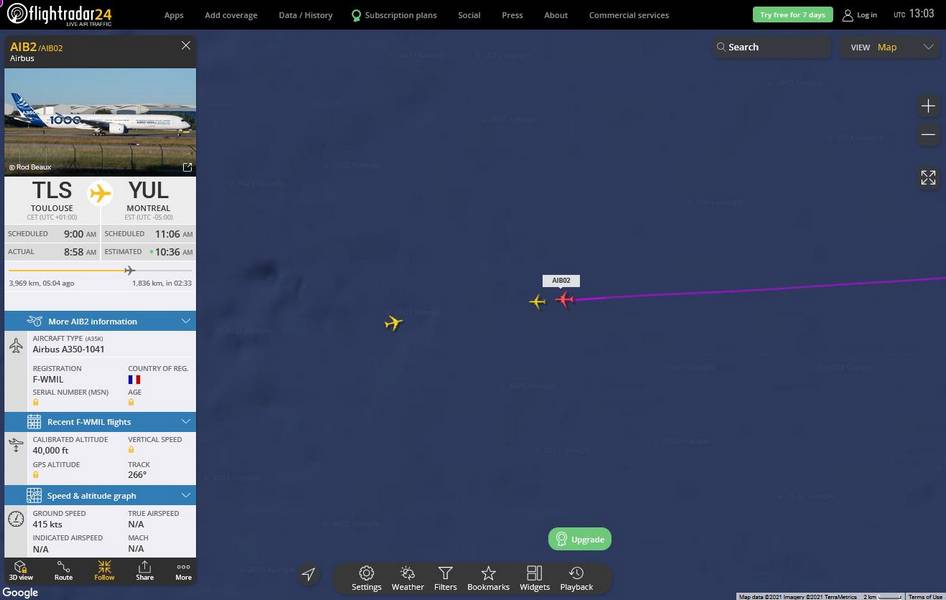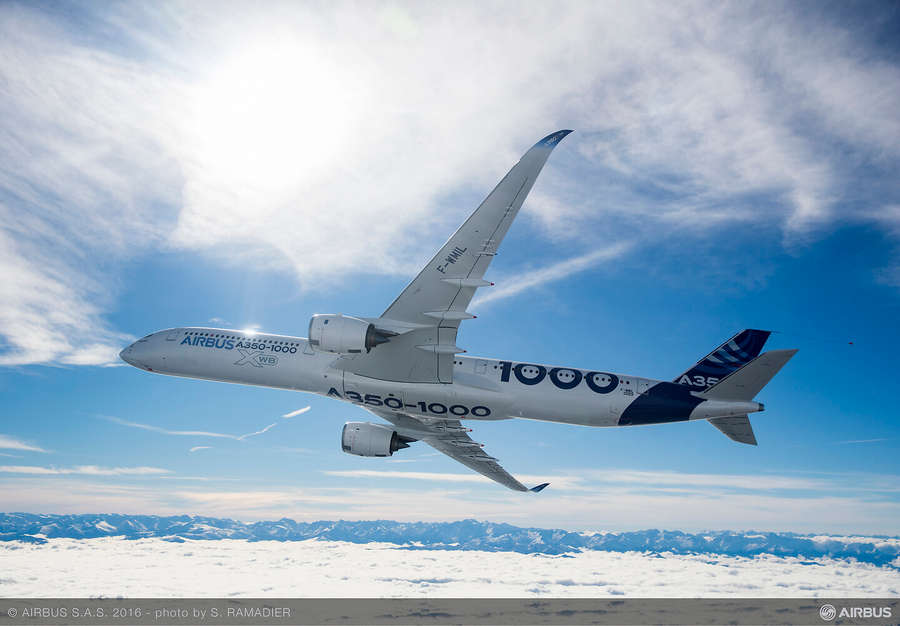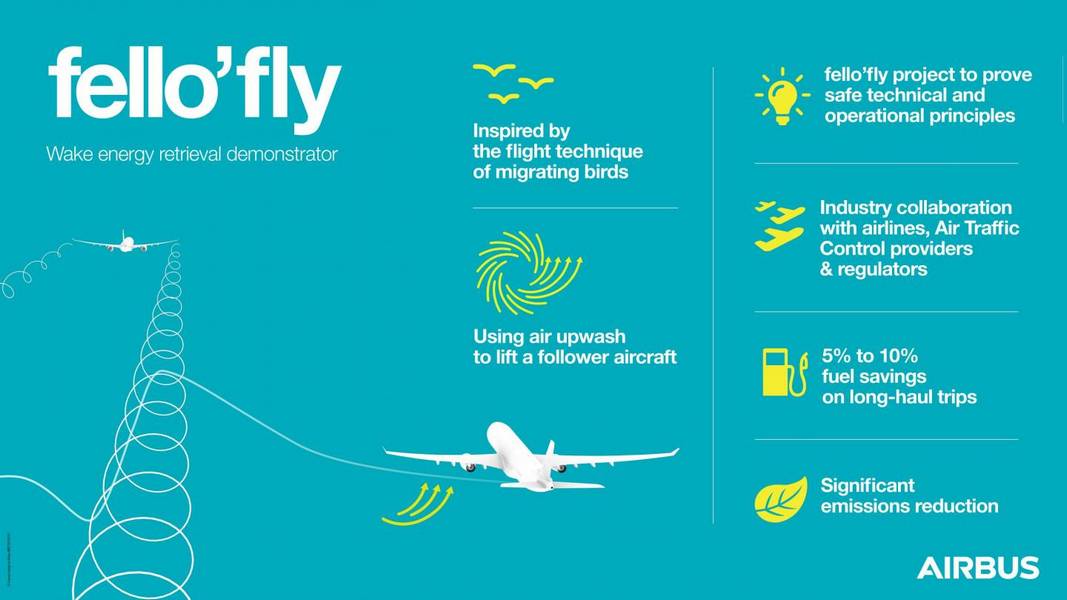Why is Airbus flying two A350 test aircraft to Canada, and why are they so close as to be called a formation? Well, it may be to save fuel!

Some very eagle-eyed aviation enthusiasts spotted something unusual happening over the Atlantic this morning (Tuesday the 9th). Two A350s were flying over the Atlantic, heading for Montreal (CYUL). Unusually, they are both Airbus test aircraft, with Airbus liveries, flying from Toulouse (LFBO). And even more unusually, the two A350 widebodies were flying in formation!
OK, this isn’t a tight “fingertip”-style formation, i.e. what we would enjoy at an airshow. But it is a formation, nonetheless. The two aircraft were flying within 1.5 miles of each other, at THE SAME FLIGHT LEVEL, one roughly behind the other. To be clear – this is far from normal. Airliners crossing the Atlantic, at the same flight level, would normally have 50 or more miles between them. Alternatively, they would have a vertical separation of 2,000 feet.

The Two A350 Widebodies In The Formation
The front A350 in the formation had flight number AIB01, and tail number F-WXWB. This is an A350-941 and the prototype for the A350-900 variant. The rear A350 is the bigger member of the family, i.e. an A350-1041. Appropriately, it has flight number AIB02, and its tail number is F-WMIL. Some keen aviation fans may know that the first of these jets has been sporting a “FlightLab” legend in its paint scheme. And this is a clue as to what is going on here.

As of this writing, there is no word from Airbus regarding this A350 formation (EDIT: there is now, see at the article’s end). But already in 2019, the manufacturer had published information on a very interesting project called “fello’fly”. We published an article on this, last December. What Airbus is doing, looks a bit similar to what geese do, when they fly in a V formation. And it is for the same reason the birds do it!
This A350 formation flying most probably another stage in the study of what Airbus calls Wake Energy Retrieval. All aircraft produce wingtip vortices. Simplistically put, these work like horizontal mini-tornados, emanating from each wingtip. Usually, aircraft avoid flying close to each other, to avoid interference and turbulence.

Stealing An Idea From Geese
But birds like to fly in such formations because if they do it right, they can make flying a bit easier on themselves. And this A350 formation is doing the same thing. The objective is for the rear aircraft to sit in the upward-moving air of one of the vortices of the front aircraft. Airbus believes that this could lead to fuel savings of 5% to 10%!

Of course, making this concept into a realistic tool for the airlines is a bit more difficult. A formation with two A350 testbeds is one thing. Getting commercial airliners to “meet” in the air, at the right time and place, is trickier. This will require both rule changes in air traffic control and sophisticated systems (and autopilot modes) on the planes themselves. And of course, combining different airliner types could present more challenges, as they don’t all “like” flying at the same speeds!
But Airbus is working together with different partners, to overcome these obstacles. This includes ATC authorities on both sides of the Atlantic. So what was an unusual formation test flight today, could be part of a routine flight tomorrow for you and me – in an A350 or other Airbus. Or a Boeing, too.
EDIT: Airbus released this post, about the flight:
These two #A350 “fellos” performed the 1st transatlantic flight as paired aircraft from Toulouse to Montreal airport!
What's #fellofly? A follower ✈️ retrieves wake energy lost by a leader ✈️, reducing engine thrust & fuel consumption of over 5% per trip.
Watch to find out more. pic.twitter.com/xt6w2h11RB— Airbus (@Airbus) November 9, 2021




1 comment
Paul Courtnage
Generally speaking, an aircraft formating on another will consume more fuel than one flying alone. I would like to see what results Airbus obtained by doing this and how they actually did it. Assuming that the lead aircraft is either flying a set speed of a fixed power setting, the other aircraft will have to make continual (albeit small) changes to thrust to maintain position. This of course causes a measurable difference in fuel consumption. The closer you fly, the bigger this effect becomes.
It also increases workload for the second aircraft’s pilot. I can vouch for this having formated on an air-to-air refuelling tanker all the way from the UK to the Falkland Islands.(in two stages). It requires different different formation positions for day VMC, Night VMC and IMC. The next issue is the need for “escape manoeuvres” in the event of lost visual contact or aircraft emergencies for either aircraft.
Of course the other advantages include having only one speaking unit and two completely independent sets of navigation equipment. Geese don’t care much about those!
As you have rightly mentioned, joining up can be an issue as can gaining separation when required. I would like to be convinced that the fuel savings are worth all the other factors.